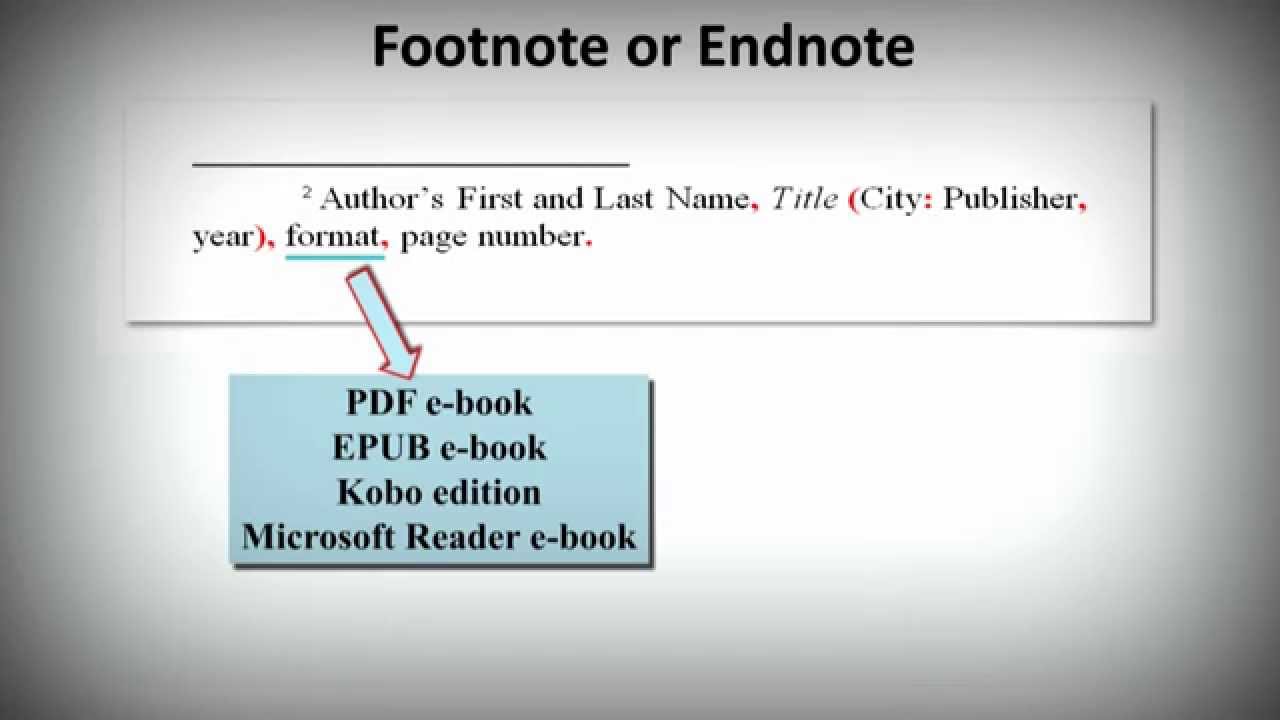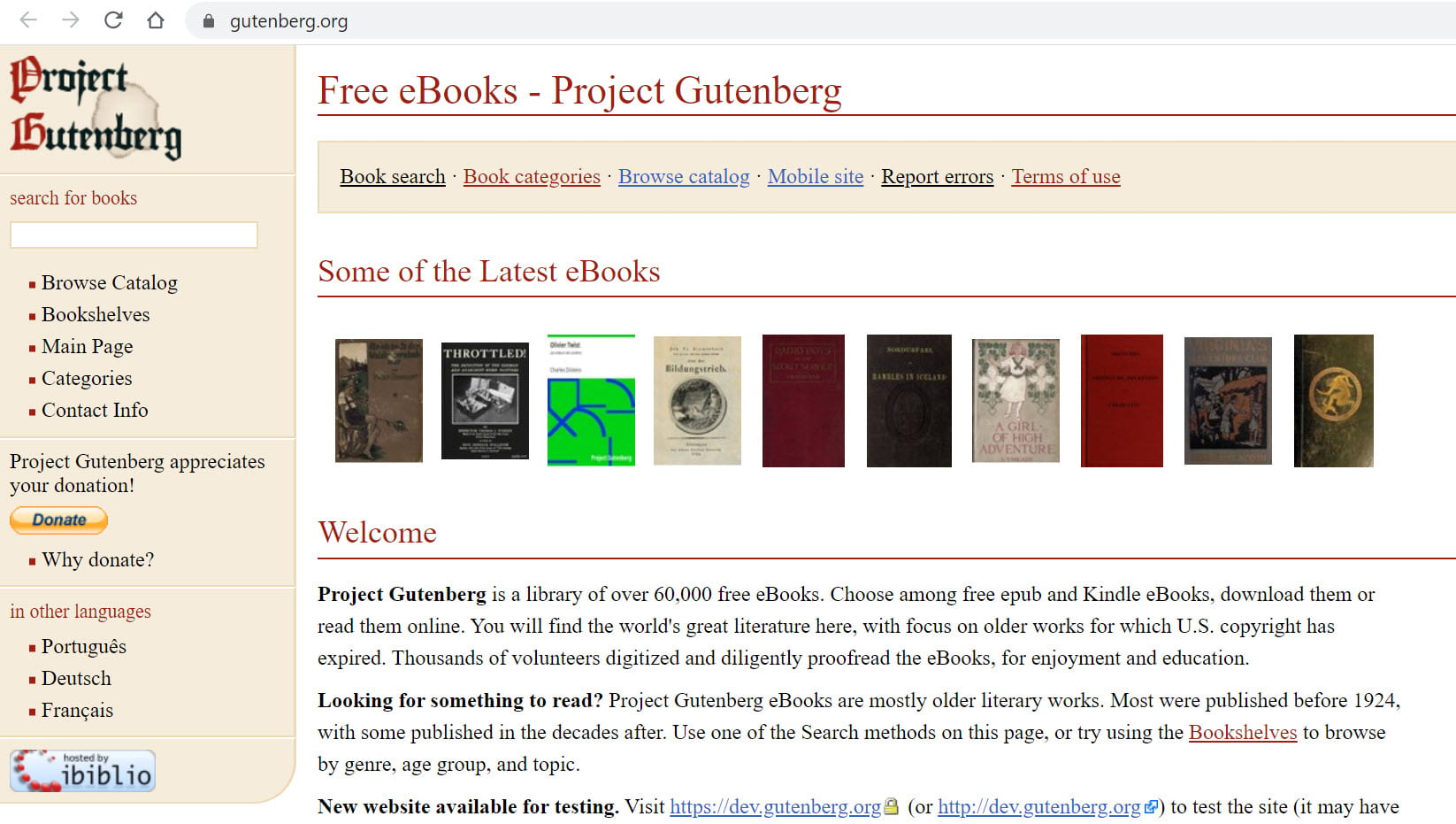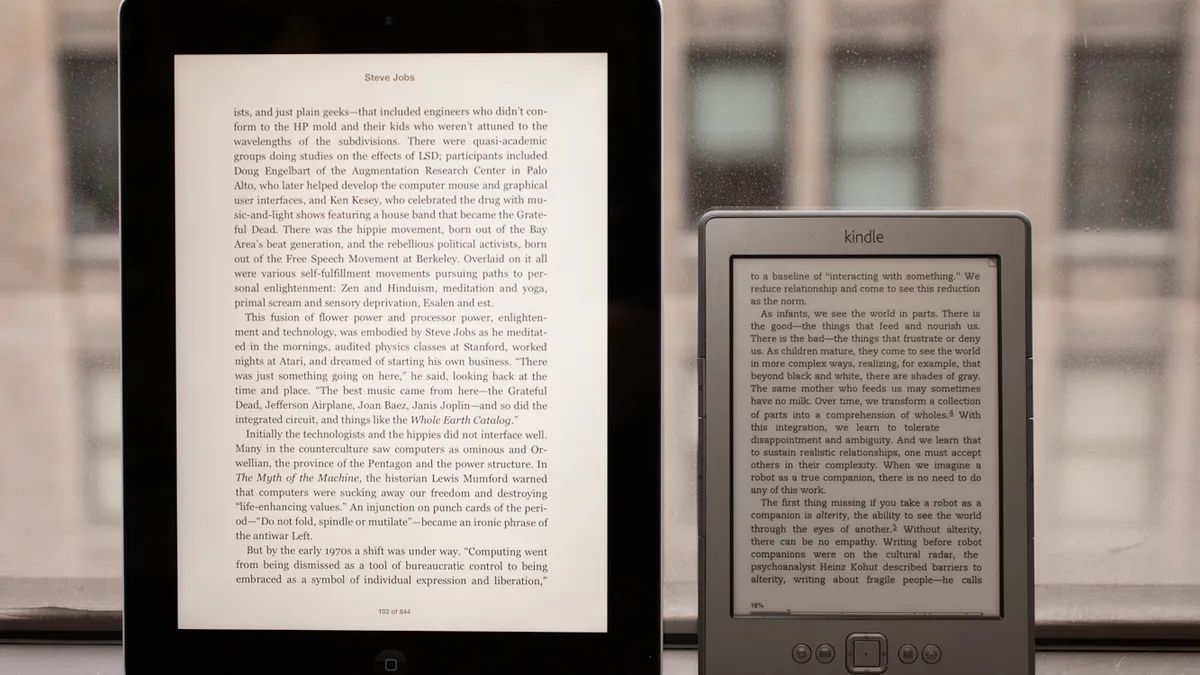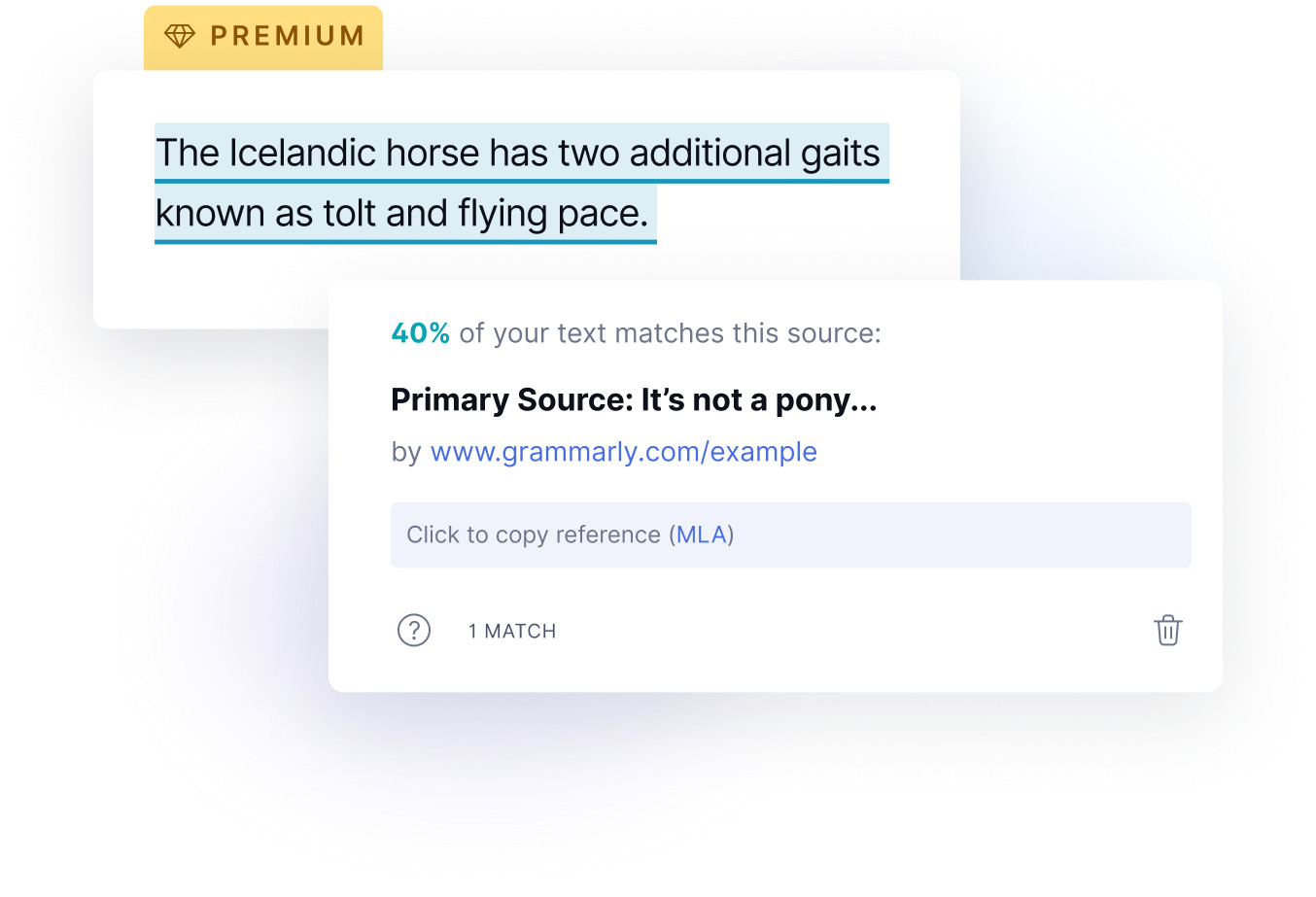Introduction
Welcome to the comprehensive guide on how to cite an eBook in Chicago style! As an SEO writer, I understand the importance of properly formatting citations to ensure accuracy and credibility. The Chicago style is commonly used in the humanities and social sciences, providing guidelines for citing various sources, including eBooks.
With the ever-increasing availability and accessibility of eBooks, it is essential to know how to cite them correctly to give proper credit to the authors and maintain academic integrity. By following the guidelines outlined in this article, you will be able to cite eBooks in Chicago style confidently.
Chicago style offers specific rules for different types of eBooks, including those with one or more authors, edited or translated books, eBooks with multiple volumes or editions, and those with a DOI or URL.
In this guide, we will cover the basics of Chicago style citation for eBooks, including the general format, in-text citations, and examples for different scenarios. Whether you are a student, researcher, or writer, this article will serve as your go-to resource for citing eBooks in Chicago style accurately.
Chicago style citations follow a Notes and Bibliography system, where you use footnotes or endnotes for in-text citations and a separate bibliography page for the full citation details. This system allows readers to easily locate the specific sources referenced in your work.
Now, let’s dive into the specifics of citing eBooks in Chicago style. Whether you are citing a PDF eBook, an eBook from a database, or one accessed through an app or e-reader, we have you covered. Let’s explore the different scenarios and the appropriate citation formats to ensure your sources are properly acknowledged.
Understanding Chicago Style
Before we delve into the specifics of citing eBooks in Chicago style, it’s essential to have a solid understanding of the Chicago Manual of Style (CMOS) guidelines. The Chicago style is widely used in the fields of history, literature, and the arts, providing a comprehensive system for citing sources and formatting academic papers.
One of the distinct features of Chicago style is the use of footnotes or endnotes in conjunction with a bibliography. This allows for thorough and detailed referencing without interrupting the flow of the main text. Each footnote or endnote contains a superscript number that corresponds to the full citation in the bibliography.
In Chicago style, the bibliography is a separate page at the end of your document, listing all the sources you have cited or consulted in your research. Each source entry in the bibliography follows a specific format, including the author’s name, the title of the work, publication information, and other relevant details.
Chicago style also provides guidelines for in-text citations, which direct readers to the footnotes or endnotes. These citations are typically used when providing direct quotes, paraphrasing, or including specific information from a source.
It’s important to note that Chicago style offers two different citation systems: the Notes and Bibliography system and the Author-Date system. In this guide, we will focus on the Notes and Bibliography system, which is commonly used in the humanities and social sciences.
When citing eBooks in Chicago style, you will follow the same overarching principles as when citing print books. However, there are some specific considerations for eBooks, such as indicating the format (e.g., Kindle, PDF, EPUB) and providing a DOI (Digital Object Identifier) or URL if applicable.
Now that we have a solid understanding of the Chicago style and its general principles, let’s move on to the specifics of citing eBooks in this style.
Citing an eBook in Chicago Style
When it comes to citing eBooks in Chicago style, it’s important to follow the guidelines set forth by the Chicago Manual of Style. Whether you are citing an eBook with one author, multiple authors, an editor or translator, or even an eBook with a DOI or URL, the citation format will depend on the specific details of the eBook.
The basic format for citing an eBook in Chicago style includes the author’s name, the title of the book in italics or underlined, the place of publication, the publisher, the year of publication, and the format. Additionally, you may need to include other information such as the edition, volume number, or page numbers, depending on the eBook’s specific details.
For eBooks with one author, the citation format follows this pattern:
Author’s Last Name, Author’s First Name. Title of Book. Place of Publication: Publisher, Year of Publication. Format.
If the eBook has multiple authors, the citation format will include the names of all the authors, separated by commas. For example:
Author’s Last Name, Author’s First Name, and Author’s First Name Last Name. Title of Book. Place of Publication: Publisher, Year of Publication. Format.
When citing an eBook with an editor or translator, include their name after the title of the book, followed by “ed.” or “trans.” For example:
Author’s Last Name, Author’s First Name. Title of Book, edited by Editor’s First Name Last Name. Place of Publication: Publisher, Year of Publication. Format.
If the eBook has multiple volumes, indicate the volume number after the title of the book. For example:
Author’s Last Name, Author’s First Name. Title of Book, vol. Volume Number. Place of Publication: Publisher, Year of Publication. Format.
For eBooks with an edition, include the edition number after the title of the book.
Author’s Last Name, Author’s First Name. Title of Book. Edition Number ed. Place of Publication: Publisher, Year of Publication. Format.
If the eBook has a DOI (Digital Object Identifier) or URL, include it at the end of the citation.
Author’s Last Name, Author’s First Name. Title of Book. Place of Publication: Publisher, Year of Publication. Format. DOI or URL.
For eBooks with specific page numbers, include the page range after the year of publication.
Author’s Last Name, Author’s First Name. Title of Book. Place of Publication: Publisher, Year of Publication, pp. Page Range. Format.
If you are citing an eBook from a database, provide the name of the database followed by the DOI or URL.
Author’s Last Name, Author’s First Name. Title of Book. Place of Publication: Publisher, Year of Publication. Format. Database Name, DOI or URL.
For eBooks accessed through an app or e-reader, include the name of the app or e-reader platform in the citation.
Author’s Last Name, Author’s First Name. Title of Book. Place of Publication: Publisher, Year of Publication. Format. App or E-Reader Platform.
By following the appropriate citation format for your eBook, you will ensure that your sources are properly credited and your work adheres to the Chicago style guidelines.
Basic Format
When citing eBooks in Chicago style, it is important to follow a consistent and accurate format to ensure proper citation and credit to the original authors. The basic format for citing an eBook in Chicago style includes key elements such as the author’s name, the title of the book, the place of publication, the publisher, the year of publication, and the format of the eBook.
Below is the basic format for citing an eBook in Chicago style:
Author’s Last Name, Author’s First Name. Title of Book. Place of Publication: Publisher, Year of Publication. Format.
Let’s break down each element:
- Author’s Last Name, Author’s First Name: Begin the citation with the last name of the author, followed by a comma and the author’s first name. If the eBook has multiple authors, separate their names with commas.
- Title of Book: Italicize or underline the title of the eBook. This element should be followed by a period.
- Place of Publication: Provide the name of the city where the eBook was published. If multiple cities are listed, include only the first one.
- Publisher: State the name of the publisher who published the eBook. Omit terms such as “Publishing” or “Publishers” from the publisher’s name.
- Year of Publication: Indicate the specific year the eBook was published.
- Format: Specify the format of the eBook, such as Kindle, PDF, EPUB, or another compatible electronic format.
By following this basic format, you are providing readers with all the necessary information to locate and access the eBook you are citing. However, keep in mind that the specific citation elements may vary depending on the eBook’s details, such as multiple volumes, editions, or the presence of a DOI or URL.
When citing eBooks, always consult the original source or documentation provided by the publisher or online platform to ensure accurate and complete citation. This will help you maintain the integrity of your work and give proper credit to the authors.
Now that we have covered the basic format for citing eBooks in Chicago style, let’s explore specific citation examples for different scenarios, including eBooks with one author, multiple authors, editors or translators, and various other details.
Book with One Author
When citing an eBook with one author in Chicago style, the basic format remains the same, but you will incorporate the author’s name into the citation. Following the standard structure, the citation includes the author’s last name, first name, the title of the book in italics or underlined, the place of publication, the publisher, the year of publication, and the format of the eBook.
Here is an example of how to cite a book with one author:
Author’s Last Name, Author’s First Name. Title of Book. Place of Publication: Publisher, Year of Publication. Format.
Let’s break down the elements:
- Author’s Last Name, Author’s First Name: Begin the citation with the last name of the author, followed by a comma and the author’s first name.
- Title of Book: Italicize or underline the title of the eBook. Remember to use title case, capitalizing the first letter of each major word.
- Place of Publication: Indicate the city where the eBook was published. If multiple cities are listed, include only the first one.
- Publisher: State the name of the publisher who published the eBook. Omit terms such as “Publishing” or “Publishers” from the name.
- Year of Publication: Provide the specific year the eBook was published.
- Format: Specify the format of the eBook, such as Kindle, PDF, EPUB, or another compatible electronic format.
Here is an example citation for a book with one author:
Smith, John. The Art of Writing. New York: ABC Publisher, 2022. Kindle.
Remember to consult the actual eBook and any accompanying documentation for the most accurate information when constructing your citation. These guidelines will help you provide proper credit to the author and allow readers to easily access and locate the eBook you are referencing.
Now that you are familiar with how to cite a book with one author in Chicago style, let’s move on to books with multiple authors and explore the appropriate citation format.
Book with Two or More Authors
When citing an eBook with two or more authors in Chicago style, the citation format includes the names of all the authors, separated by commas. The rest of the citation elements remain the same as for a book with one author.
Here is an example of how to cite a book with two or more authors in Chicago style:
Author’s Last Name, Author’s First Name, and Author’s First Name Last Name. Title of Book. Place of Publication: Publisher, Year of Publication. Format.
Let’s break down the elements:
- Author’s Last Name, Author’s First Name: Begin the citation with the last name of the first author, followed by a comma and the first name of the first author.
- and: Use the word “and” to indicate the separation between the first author and the second author.
- Author’s First Name Last Name: Provide the first name and last name of the second author, following the same comma and first name format.
- Title of Book: Italicize or underline the title of the eBook using proper title case.
- Place of Publication: Indicate the city where the eBook was published. Include only the first city if multiple cities are listed.
- Publisher: State the name of the publisher without including terms like “Publishing” or “Publishers”.
- Year of Publication: Specify the specific year the eBook was published.
- Format: Indicate the format of the eBook, such as PDF, EPUB, Kindle, or another compatible electronic format.
Here is an example citation for a book with two authors:
Smith, John, and Anne Johnson. The History of Art. Chicago: XYZ Publisher, 2022. PDF.
If the eBook has more than two authors, list all the authors’ names in the same format, separating each name with a comma. The last author’s name should be preceded by the word “and”. For example:
Smith, John, Anne Johnson, and Robert Davis. The History of Art. Chicago: XYZ Publisher, 2022. eBook.
Remember to consult the eBook itself or any accompanying documentation for accurate author names and other relevant information when constructing your citation. Properly citing a book with two or more authors in Chicago style ensures authors receive proper credit and allows readers to locate the eBook you are referencing.
Now that we have covered books with multiple authors, let’s move on to books with an editor or translator, and learn the appropriate citation format.
Book with an Editor or Translator
When citing an eBook with an editor or a translator in Chicago style, it is important to include their name in the citation to acknowledge their contribution to the work. The citation format for a book with an editor or translator includes the names of the author and the editor/translator, the title of the book, the place of publication, the publisher, the year of publication, and the format of the eBook.
Here is an example of how to cite a book with an editor or translator in Chicago style:
Author’s Last Name, Author’s First Name. Title of Book, edited/translated by Editor’s/Translator’s First Name Last Name. Place of Publication: Publisher, Year of Publication. Format.
Let’s break down the elements:
- Author’s Last Name, Author’s First Name: Begin the citation with the last name of the author, followed by a comma and the author’s first name.
- Title of Book: Italicize or underline the title of the eBook using proper title case.
- edited/translated by: Indicate whether the contributor is an editor or translator, using the appropriate term.
- Editor’s/Translator’s First Name Last Name: Provide the first name and last name of the editor or translator, following the comma and first name format.
- Place of Publication: State the city where the eBook was published. If multiple cities are listed, include only the first one.
- Publisher: Include the name of the publisher without including terms like “Publishing” or “Publishers”.
- Year of Publication: Specify the specific year the eBook was published.
- Format: Indicate the format of the eBook, such as PDF, EPUB, Kindle, or another compatible electronic format.
Here is an example citation for a book with an editor:
Smith, John. The History of Art, edited by Anne Johnson. New York: XYZ Publisher, 2022. EPUB.
If the eBook has a translator instead of an editor, use the term “translated by” instead of “edited by”. For example:
Smith, John. The History of Art, translated by Anne Johnson. New York: XYZ Publisher, 2022. Kindle.
Remember to consult the eBook itself or any accompanying documentation for accurate editor or translator names and other relevant information when constructing your citation. By properly acknowledging the contributions of editors or translators, you give credit to their work and ensure readers can locate the eBook you are referencing.
Now that we have covered books with editors or translators in Chicago style, let’s move on to eBooks with multiple volumes and explore the appropriate citation format.
eBooks with Multiple Volumes
When citing eBooks with multiple volumes in Chicago style, it is essential to indicate the specific volume number in the citation. This allows readers to understand which volume of the eBook you are referencing. The citation format for eBooks with multiple volumes follows the same structure as the basic format, with the addition of the volume number.
Here is an example of how to cite an eBook with multiple volumes in Chicago style:
Author’s Last Name, Author’s First Name. Title of Book, vol. Volume Number. Place of Publication: Publisher, Year of Publication. Format.
Let’s break down the elements:
- Author’s Last Name, Author’s First Name: Begin the citation with the last name of the author, followed by a comma and the author’s first name.
- Title of Book: Italicize or underline the title of the eBook using proper title case.
- vol. Volume Number: Indicate the specific volume number of the eBook. Use the abbreviation “vol.” and follow it with the volume number.
- Place of Publication: State the name of the city where the eBook was published. If multiple cities are listed, include only the first one.
- Publisher: Include the name of the publisher without terms like “Publishing” or “Publishers”.
- Year of Publication: Specify the exact year the eBook was published.
- Format: Indicate the format of the eBook, such as PDF, EPUB, Kindle, or another compatible electronic format.
Here is an example citation for an eBook with multiple volumes:
Smith, John. The History of Art, vol. 2. New York: XYZ Publisher, 2022. PDF.
Remember to consult the eBook or any accompanying documentation to retrieve accurate volume numbers when constructing your citation. Providing the volume number ensures proper credit to the author and allows readers to access the specific volume of the eBook you are referencing.
Now that we have covered eBooks with multiple volumes in Chicago style, let’s move on to eBooks with an edition and explore the appropriate citation format.
eBooks with an Edition
When citing eBooks with an edition in Chicago style, it is important to specify the edition number in the citation. This information helps readers identify the specific edition of the eBook you are referencing. The citation format for eBooks with an edition follows the standard structure, with the inclusion of the edition number.
Here is an example of how to cite an eBook with an edition in Chicago style:
Author’s Last Name, Author’s First Name. Title of Book. Edition Number ed. Place of Publication: Publisher, Year of Publication. Format.
Let’s break down the elements:
- Author’s Last Name, Author’s First Name: Begin the citation with the last name of the author, followed by a comma and the author’s first name.
- Title of Book: Italicize or underline the title of the eBook using proper title case.
- Edition Number ed.: Indicate the specific edition number of the eBook. Use the abbreviation “ed.” followed by the edition number.
- Place of Publication: State the name of the city where the eBook was published. If multiple cities are listed, include only the first one.
- Publisher: Include the name of the publisher without terms like “Publishing” or “Publishers”.
- Year of Publication: Specify the exact year the eBook was published.
- Format: Indicate the format of the eBook, such as PDF, EPUB, Kindle, or another compatible electronic format.
Here is an example citation for an eBook with an edition:
Smith, John. The History of Art. 2nd ed. New York: XYZ Publisher, 2022. PDF.
Remember to consult the eBook or any accompanying documentation to retrieve accurate edition numbers when constructing your citation. Including the edition number ensures proper credit to the author and allows readers to access the specific edition of the eBook you are referencing.
Now that we have covered eBooks with an edition in Chicago style, let’s move on to citing eBooks with a DOI or URL and explore the appropriate citation format.
eBooks with a DOI or URL
When citing eBooks in Chicago style, it is important to include a Digital Object Identifier (DOI) or a URL if one is available. This helps readers easily access the eBook online. The citation format for eBooks with a DOI or URL follows the standard structure, with the addition of the DOI or URL at the end of the citation.
Here is an example of how to cite an eBook with a DOI or URL in Chicago style:
Author’s Last Name, Author’s First Name. Title of Book. Place of Publication: Publisher, Year of Publication. Format. DOI or URL.
Let’s break down the elements:
- Author’s Last Name, Author’s First Name: Begin the citation with the last name of the author, followed by a comma and the author’s first name.
- Title of Book: Italicize or underline the title of the eBook using proper title case.
- Place of Publication: State the name of the city where the eBook was published. If multiple cities are listed, include only the first one.
- Publisher: Include the name of the publisher without terms like “Publishing” or “Publishers”.
- Year of Publication: Specify the exact year the eBook was published.
- Format: Indicate the format of the eBook, such as PDF, EPUB, Kindle, or another compatible electronic format.
- DOI or URL: Provide the DOI (Digital Object Identifier) if one is available. If there is no DOI, include the full URL where the eBook can be accessed.
Here is an example citation for an eBook with a DOI:
Smith, John. The History of Art. New York: XYZ Publisher, 2022. PDF. DOI: 10.1234/5678.
If the eBook does not have a DOI but is accessed through a URL, include the full URL at the end of the citation. For example:
Smith, John. The History of Art. New York: XYZ Publisher, 2022. PDF. Available at: www.example.com/ebook.
Remember to consult the eBook or any accompanying documentation to retrieve accurate DOI or URL information when constructing your citation. Including the DOI or URL ensures that readers can easily locate and access the eBook you are referencing.
Now that we have covered eBooks with a DOI or URL in Chicago style, let’s explore how to cite eBooks with page numbers and the appropriate citation format.
eBooks with Page Numbers
When citing eBooks in Chicago style, it is important to include page numbers if they are available. This helps readers navigate to specific sections or passages within the eBook. The citation format for eBooks with page numbers follows the standard structure, with the addition of the page range.
Here is an example of how to cite an eBook with page numbers in Chicago style:
Author’s Last Name, Author’s First Name. Title of Book. Place of Publication: Publisher, Year of Publication, pp. Page Range. Format.
Let’s break down the elements:
- Author’s Last Name, Author’s First Name: Begin the citation with the last name of the author, followed by a comma and the author’s first name.
- Title of Book: Italicize or underline the title of the eBook using proper title case.
- Place of Publication: State the name of the city where the eBook was published. If multiple cities are listed, include only the first one.
- Publisher: Include the name of the publisher without terms like “Publishing” or “Publishers”.
- Year of Publication: Specify the exact year the eBook was published.
- pp. Page Range: Include the abbreviation “pp.” to indicate multiple pages. Specify the range of pages you are citing, separated by an en dash (-).
- Format: Indicate the format of the eBook, such as PDF, EPUB, Kindle, or another compatible electronic format.
Here is an example citation for an eBook with page numbers:
Smith, John. The History of Art. New York: XYZ Publisher, 2022, pp. 45-72. PDF.
Remember to consult the eBook or any accompanying documentation to retrieve accurate page numbers when constructing your citation. Including the page range allows readers to easily locate and refer to the specific pages you are referencing within the eBook.
Now that we have covered eBooks with page numbers in Chicago style, let’s move on to citing eBooks from a database, and explore the appropriate citation format.
eBooks from a Database
When citing eBooks from a database in Chicago style, it is important to include the name of the database as well as the DOI or URL for the eBook. This citation format allows readers to access the eBook directly from the database. The citation structure for eBooks from a database includes the author’s name, the title of the eBook, the place of publication, the publisher, the year of publication, the format, the name of the database, and the DOI or URL.
Here is an example of how to cite an eBook from a database in Chicago style:
Author’s Last Name, Author’s First Name. Title of Book. Place of Publication: Publisher, Year of Publication. Format. Database Name, DOI or URL.
Let’s break down the elements:
- Author’s Last Name, Author’s First Name: Begin the citation with the last name of the author, followed by a comma and the author’s first name.
- Title of Book: Italicize or underline the title of the eBook using proper title case.
- Place of Publication: State the name of the city where the eBook was published. If multiple cities are listed, include only the first one.
- Publisher: Include the name of the publisher without terms like “Publishing” or “Publishers”.
- Year of Publication: Specify the exact year the eBook was published.
- Format: Indicate the format of the eBook, such as PDF, EPUB, Kindle, or another compatible electronic format.
- Database Name: Provide the name of the database where the eBook is hosted. This can be found in the database’s documentation or website.
- DOI or URL: Include the DOI (Digital Object Identifier) if available. If not, provide the full URL that leads directly to the eBook within the database.
Here is an example citation for an eBook from a database:
Smith, John. The History of Art. New York: XYZ Publisher, 2022. PDF. Database Name, DOI: 10.1234/5678.
If the eBook does not have a DOI but is accessed through a URL, include the full URL instead. For example:
Smith, John. The History of Art. New York: XYZ Publisher, 2022. PDF. Database Name, Available at: www.example.com/ebook.
Remember to consult the specific database and any accompanying documentation for accurate information when constructing your citation. Properly citing eBooks from a database ensures readers can directly access the eBook you are referencing and gives credit to the author.
Now that we have covered eBooks from a database in Chicago style, let’s move on to citing eBooks accessed through an app or e-reader, and explore the appropriate citation format.
eBooks from an App or Ereader
When citing eBooks accessed through an app or e-reader in Chicago style, it is important to include the name of the app or e-reader platform in the citation. This information helps readers understand the specific platform used to access the eBook. The citation format for eBooks from an app or e-reader includes the author’s name, the title of the eBook, the place of publication, the publisher, the year of publication, the format, and the name of the app or e-reader platform.
Here is an example of how to cite an eBook from an app or e-reader in Chicago style:
Author’s Last Name, Author’s First Name. Title of Book. Place of Publication: Publisher, Year of Publication. Format. App or E-Reader Platform.
Let’s break down the elements:
- Author’s Last Name, Author’s First Name: Begin the citation with the last name of the author, followed by a comma and the author’s first name.
- Title of Book: Italicize or underline the title of the eBook using proper title case.
- Place of Publication: State the name of the city where the eBook was published. If multiple cities are listed, include only the first one.
- Publisher: Include the name of the publisher without terms like “Publishing” or “Publishers”.
- Year of Publication: Specify the exact year the eBook was published.
- Format: Indicate the format of the eBook, such as PDF, EPUB, Kindle, or another compatible electronic format.
- App or E-Reader Platform: Specify the name of the app or e-reader platform used to access the eBook.
Here is an example citation for an eBook from an app or e-reader:
Smith, John. The History of Art. New York: XYZ Publisher, 2022. PDF. Kindle.
Remember to consult the specific app or e-reader platform and any accompanying documentation for accurate information when constructing your citation. Including the app or e-reader platform helps readers understand the medium through which the eBook was accessed.
Now that we have covered citing eBooks from an app or e-reader in Chicago style, let’s move on to in-text citations for eBooks and explore the appropriate format.
In-text Citations for eBooks
In-text citations for eBooks in Chicago style follow the Notes and Bibliography system, where citations are provided as footnotes or endnotes. These citations help readers quickly locate the specific source you are referencing within your text. The citation format includes the author’s name, the title of the book (in italics or underlined), and the specific page number or range.
Here is an example of how to cite an eBook in Chicago style in the text:
Author’s Last Name, Title of Book, Page Number(s).
Using this format, the author’s last name is followed by a comma. The title of the book is in italics or underlined, depending on your preferred formatting style. Include the specific page number or page range to pinpoint the source material.
For example:
According to Smith, The History of Art, 45.
If you are citing multiple pages, use a page range:
(Smith, The History of Art, 45-48).
Ensure that the corresponding footnote or endnote contains the full citation information, as discussed in the previous sections, so readers can refer to the complete source information in your bibliography section.
It is important to note that if you are frequently referring to the same eBook within your text, you can use a shortened version of the citation in subsequent references. This shortened citation includes the author’s last name, a shortened title, and the specific page number.
For example:
Smith, History of Art, 45.
In this shortened citation, you omit the author’s first name and any additional title words beyond the first significant word.
Remember to consult the Chicago Manual of Style or your specific style guide for any variations or additional specifications required for in-text citations in your field of study.
Now that we have covered in-text citations for eBooks in Chicago style, let’s move on to abbreviation guidelines for commonly used terms within eBook citations.
Abbreviations
Abbreviations are commonly used in Chicago style citations to maintain conciseness and improve readability. It is important to follow the appropriate abbreviation guidelines to ensure consistency and accuracy in your citations. Here are some commonly used abbreviations in eBook citations:
- ed. – for “edited by”. Use this abbreviation when citing an eBook that has an editor.
- trans. – for “translated by”. Use this abbreviation when citing an eBook that has a translator.
- vol. – for “volume”. Use this abbreviation when citing an eBook that consists of multiple volumes.
- ed. – for “edition”. Use this abbreviation when citing an eBook that has a specific edition.
- pp. – for “pages”. Use this abbreviation when citing an eBook that has specific page numbers.
- et al. – for “and others”. Use this abbreviation when citing an eBook with three or more authors.
It is important to note that these abbreviations should be used appropriately and sparingly to maintain clarity in your citations. Avoid excessive use of abbreviations, as it may hinder readability and comprehension.
When constructing your citations, always consider the context and the specific citation requirements for each eBook. Consult the Chicago Manual of Style or your specific style guide for any additional abbreviation guidelines that may apply to your field of study or discipline.
Now that we have covered abbreviations in eBook citations, let’s move on to the next section and explore some examples of citations for different types of eBooks in Chicago style.
Examples
Now let’s take a look at some examples of citations for different types of eBooks in Chicago style. These examples will demonstrate how to apply the citation format discussed earlier for eBooks with varying characteristics.
1. eBook with One Author:
Smith, John. The Art of Writing. New York: ABC Publisher, 2022. Kindle.
2. eBook with Two Authors:
Smith, John, and Anne Johnson. The History of Art. Chicago: XYZ Publisher, 2022. eBook.
3. eBook with an Editor:
Smith, John. The History of Art, edited by Anne Johnson. New York: XYZ Publisher, 2022. EPUB.
4. eBook with Multiple Volumes:
Smith, John. The History of Art, vol. 2. New York: XYZ Publisher, 2022. PDF.
5. eBook with an Edition:
Smith, John. The History of Art. 2nd ed. New York: XYZ Publisher, 2022. Kindle.
6. eBook with a DOI:
Smith, John. The History of Art. New York: XYZ Publisher, 2022. PDF. DOI: 10.1234/5678.
7. eBook with Page Numbers:
Smith, John. The History of Art. New York: XYZ Publisher, 2022, pp. 45-72. PDF.
8. eBook from a Database:
Smith, John. The History of Art. New York: XYZ Publisher, 2022. PDF. Database Name, DOI: 10.1234/5678.
9. eBook from an App:
Smith, John. The History of Art. New York: XYZ Publisher, 2022. PDF. Kindle.
Remember to adjust the details, such as author names, titles, publication information, and format, to fit the specific eBook you are citing. Consult the actual eBook and any accompanying documentation for accurate information when constructing your citations.
Now that you have examples of eBook citations in Chicago style, you can confidently apply the appropriate format to cite eBooks in your own academic or research work.
Conclusion
Citing eBooks in Chicago style is an essential skill for researchers, students, and writers in the digital age. By following the guidelines and examples provided in this comprehensive guide, you can accurately and appropriately cite eBooks in your academic or research work.
We explored the fundamental principles of Chicago style citation, including the use of footnotes or endnotes and the separate bibliography page. We discussed the basic format for citing eBooks, including books with one author, multiple authors, editors or translators, multiple volumes, editions, DOIs or URLs, page numbers, and eBooks from databases or accessed through apps or e-readers.
We also delved into in-text citations, abbreviations, and provided examples of citations for different types of eBooks. Remember to consult the Chicago Manual of Style or your specific style guide for any variations or additional specifications that may apply to your discipline or field of study.
Properly citing eBooks ensures that you give credit to the original authors, maintain academic integrity, and allow readers to locate the sources you have referenced. Additionally, accurate citations contribute to the overall credibility and transparency of your work.
As an SEO writer, it is crucial to understand the importance of accurate citations and their impact on the visibility of digital content. By adhering to the rules of Chicago style citation, you can ensure that your online articles, blog posts, and website content are well-structured, credible, and optimized for search engines.
By continually refining your skills in citing eBooks in Chicago style, you will become a more proficient researcher and writer. Remember to stay updated with the latest guidelines and standards to adapt to any changes in the citation landscape.
Now armed with the knowledge and examples provided in this guide, you are well-equipped to include accurate and properly formatted citations for eBooks in your academic and research endeavors.

























